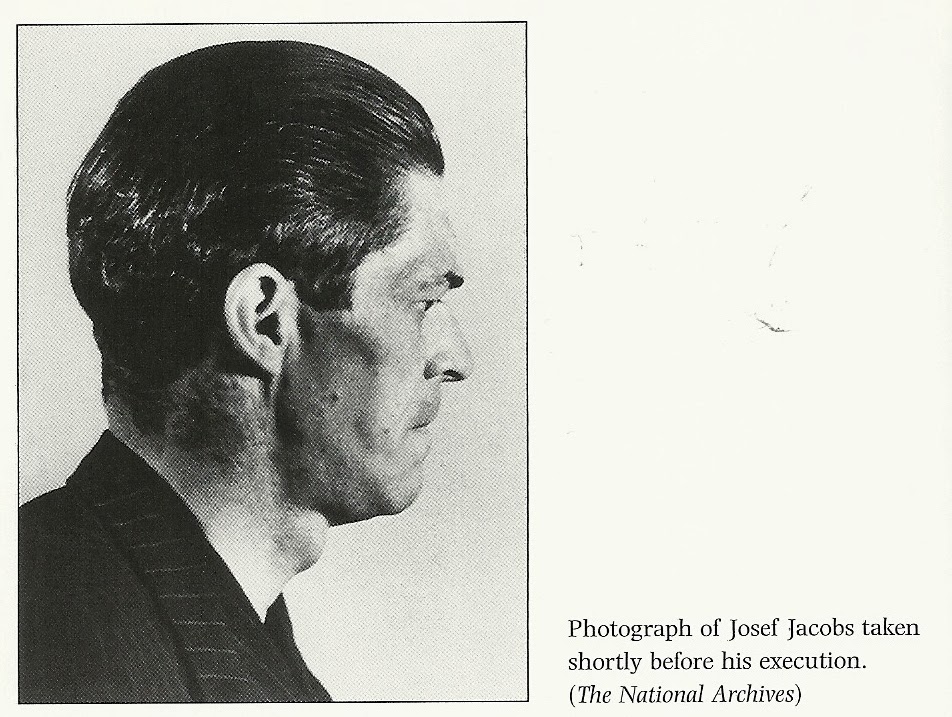The Book
Tales from the Tower of London, Daniel Diehl & Mark P. Donnelly, The History Press, 2004 edition.
Review
This book receives Average to Good reviews on Amazon. Several Amazon reviewers have noted that the book is rife with errors and historical inaccuracies. While their comments focus on inaccuracies from chapters that focus on the medieval period, I thought I would review the chapter on Josef Jakobs.
Chapter 15 is entitled The Weatherman: Josef Jakobs: 1941. The authors begin by mentioning the damage caused to the Tower during World War 2 and then reference Rudolf Hess and his brief incarceration within the Tower. From that point onwards, facts are in short supply but errors and fanciful flights of imagination are common.
It would be too much to highlight and correct all of the errors contained within this chapter. The dramatic scene that played out within the Tower in 1991 is pure fiction. No middle-aged daughter (or any relative) of Josef Jakobs ever approached a Yeoman Warder asking to see the location of her father’s execution. Josef’s only daughter died in 1946. I visited the Tower in 1991 in the company of two well-known military historians who had arranged a private tour of the Tower. The Governor of the Tower conducted the tour but never presented me with a Bible or a pair of reading glasses.
In describing Josef’s landing and capture near Ramsey in Huntingdonshire, the authors have taken liberty with many details. The farmers were on their way to work, not walking their dogs. Josef was not unconscious when they found him. He was not taken to the local hospital. Nearly every sentence contains some form of inaccuracy or exaggeration. There is also a glaring inconsistency within the book itself. The authors state Josef was balding and yet include a side-view photograph of Josef taken by MI5 which clearly shows that Josef had a full head of hair.

The section that deals with Josef’s incarceration and interrogation in London is a confusing mishmash of facts and fantasy presented within a warped timeline. The authors have stitched together information from Josef’s MI5 interrogations as well as his court martial. In the process, they have lost the factual context of the information. Josef was initially taken to New Scotland Yard before being sent to the hospital ward of Brixton Prison where he only spent a few days. He was quickly transferred to Dulwich Hospital due to the severity of his injury, where he spent the next two and a half months. From there, Josef made his way to Latchmere House and eventually Wandsworth Prison. The authors allude to a “mountain of far more damning evidence” that called Josef’s story into question. I am not aware of any documents received from the Swiss authorities and the authors provide no reference for this information. Finally, Josef was never sentenced to death by hanging at his court-martial. His sentence was always death by firing squad.
The authors create quite a bit of drama surrounding Josef’s execution. Unfortunately, once again, they have their facts wrong. Josef was transferred to the Tower of London on August 15, 1941, not August 13. He was not driven from the Waterloo Block to the firing range. The cloth pinned to his clothing was white, not black, etc.
I could continue to point out the many errors in this chapter but will end with the last two paragraphs of the chapter.I did see the chair in 1991 and at that time was asked if our family had any objection to it being put on display. We had no objections. The chair in question is not riddled with small, round holes surrounded by dark stains.
References
The authors claim that their book is meticulously researched. Given the number of errors and inaccuracies in this particular chapter, I would question that assertion. The authors provide three references for the chapter on Josef Jakobs:
- Josef Jakobs file, Public Records Office, Kew – there are actually six files which contain a significant volume of information on Josef. Unfortunately, very little of this information has made its way into the book. What has made its way in has been warped.
- Shot in the Tower by Leonard Sellers, 1997 – this book deals with spies executed at the Tower during World War I. There is a very short reference to Josef in the appendix.
- Hitler’s Jewish Spies, Jerusalem Post, 1999 – This newspaper article contains a scant 160 words on Josef and has its own inaccuracies.
Summary
The authors have a flare for the dramatic. I have no issue with incorporating drama into often dry historical accounts. I do object to the distortion of historical facts in the interest of “a good story”. This particular “Tale from the Tower” is more fiction than non-fiction.
Review Score
0 out of 5 – poorly researched, glaring errors
